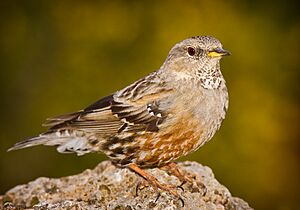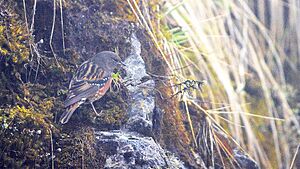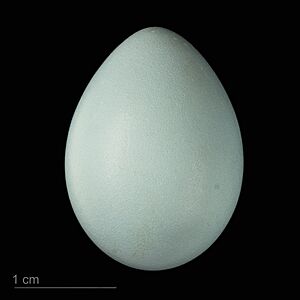Alpine accentor facts for kids
Quick facts for kids Alpine accentor |
|
|---|---|
 |
|
 |
|
| Nominate subsp. in Castellón, Spain, and P. c. nipalensis in East Sikkim, India | |
| Conservation status | |
| Scientific classification | |
| Genus: |
Prunella
|
| Species: |
collaris
|
| Synonyms | |
|
|
The alpine accentor (Prunella collaris) is a small passerine bird. This means it's a type of songbird. It belongs to the family Prunellidae. You can find these birds in Eurasia and North Africa.
Contents
Discovering the Alpine Accentor
The Alpine accentor was first described by an Austrian scientist named Giovanni Antonio Scopoli in 1769. He gave it the scientific name Sturnus collaris. The name collaris comes from Latin and means "of the neck."
Today, this bird is placed in the genus Prunella. This group name was given by a French bird expert, Louis Pierre Vieillot, in 1816. The word "accentor" means someone who sings with another. The name Prunella comes from a German word meaning "dunnock," which is another small brown bird.
Different Kinds of Alpine Accentors
There are nine different types, or subspecies, of the Alpine accentor. They are all slightly different depending on where they live:
- P. c. collaris (Scopoli, 1769) — Found from southwest Europe to Slovenia and the Carpathian Mountains, and northwest Africa.
- P. c. subalpina (Brehm, CL, 1831) — Lives from Croatia to Bulgaria and Greece, including Crete and southwest Turkey.
- P. c. montana (Hablizl, 1783) — From north and east Turkey to the Caucasus mountains and Iran.
- P. c. rufilata (Severtzov, 1879) — Found in northeast Afghanistan and north Pakistan, through the mountains of central Asia to west China.
- P. c. whymperi (Baker, ECS, 1915) — Lives in the west Himalayas.
- P. c. nipalensis (Blyth, 1843) — From the central and east Himalayas to southcentral China and north Myanmar.
- P. c. tibetana (Bianchi, 1905) — Found in east Tibet.
- P. c. erythropygia (R. Swinhoe, 1870) — Lives from east Kazakhstan and southcentral Siberia to northeast Siberia, Japan, Korea, and northeast China.
- P. c. fennelli Deignan, 1964 — Found in Taiwan.
What Does the Alpine Accentor Look Like?

This bird is about the size of a European robin. It measures about 15–17.5 cm (5.9–6.9 in) long. It's a bit bigger than its cousin, the dunnock.
The Alpine accentor has a streaked brown back. This makes it look a bit like a house sparrow. Adult birds have a grey head. They also have reddish-brown spots on their belly. Its bill is fine and pointed, which is perfect for catching insects. Both male and female birds look similar. Young birds have browner heads and bellies.
Where Alpine Accentors Live
You can find Alpine accentors in the mountains of southern Europe, Lebanon, and Asia. They usually live at heights above 2,000 m (6,600 ft). Most of these birds stay in their mountain homes all year. In winter, some might move to lower areas where it's warmer. Very rarely, some birds might fly far away, even reaching places like Great Britain.
These birds prefer bare mountain areas. They like places with some low plants and rocks.
Alpine Accentor Family Life
Alpine accentors build neat nests. They usually place them low in a bush or in a crack in a rock. The female bird lays 3 to 5 eggs. These eggs are a beautiful sky-blue color and have no spots.
Interestingly, these birds often live in groups. A group might have 3 or 4 male birds and 3 or 4 female birds. They all share a home area. The males have a pecking order, with older males often being in charge. Females will mate with different males in the group. Males also try to mate with different females. Scientists have found that chicks in one nest can have different fathers. However, the female raising the chicks is always their true mother. Male birds will help feed chicks in different nests within the group. They usually help if they are likely to be the father of those chicks.




